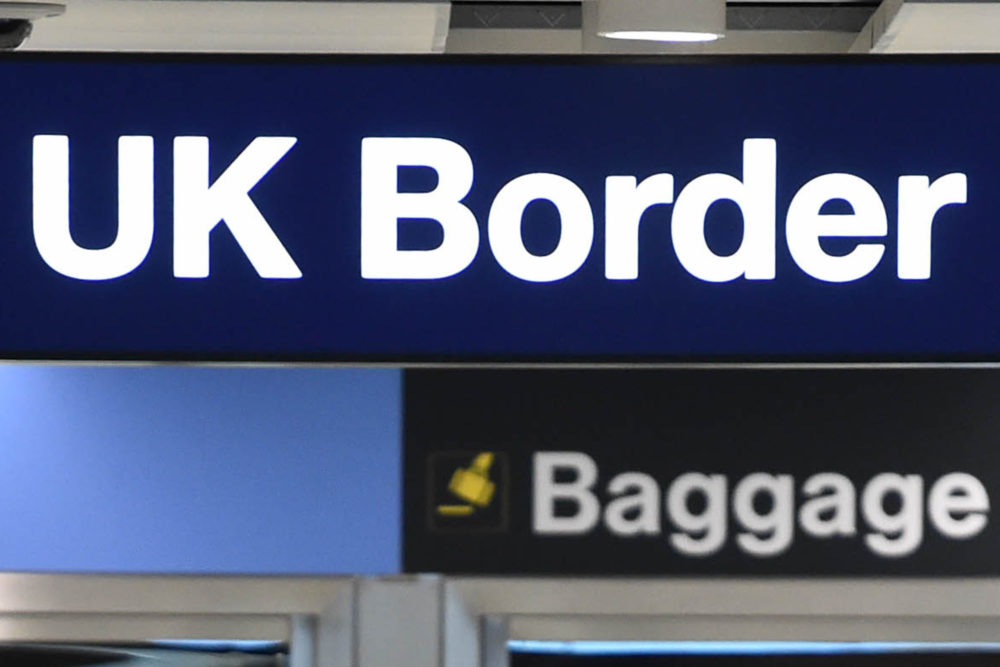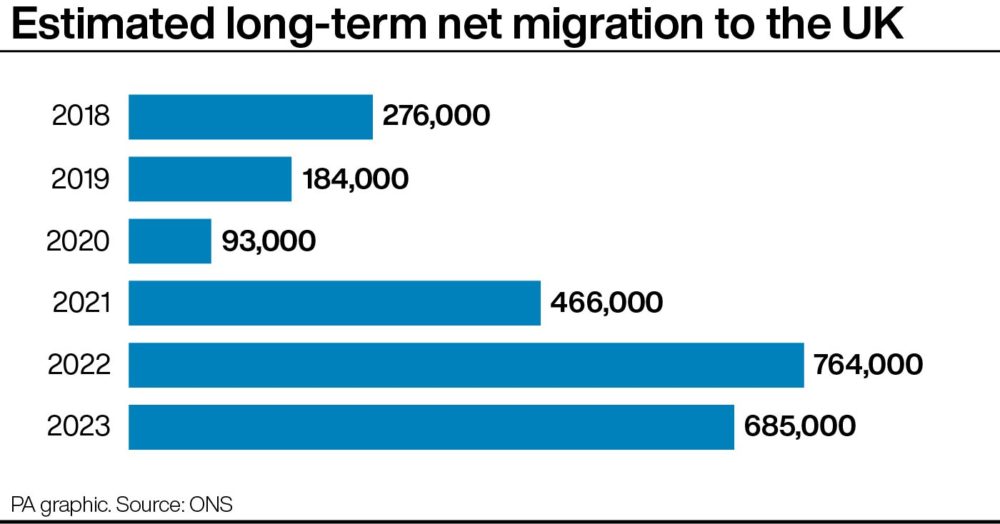Net migration ‘unusually high’ as UK heads towards General Election

Net migration remains “unusually high” as the UK heads towards an election, experts said, despite official estimates suggesting a 10% drop in numbers last year.
It comes after the measure for the difference between the number of people arriving and leaving the country hit a new record of 764,000 in 2022 – 19,000 higher than previously thought – according to revised figures from the Office for National Statistics (ONS).
The data also indicates net migration levels are estimated to have fallen in 2023 to 685,000.
But this is still more than three times higher than the figure at the time of the last election when the Conservatives promised to cut overall numbers in their 2019 manifesto.
The latest figures, published a day after the General Election was called, have fuelled the immigration debate – a key campaign battleground – with both the Conservatives and Labour claiming to hold the answer to cutting the numbers.
The Migration Observatory at the University of Oxford said net migration “remained at unusually high levels”.
The ONS – which revised its net migration figures now that more complete data is available – said it is too early to tell if this is the start of a new downward trend but that the most recent estimates indicate the number of people coming to the UK is slowing while the number of those leaving is rising.
Health and care workers
Work was the biggest driver of migration in 2023, overtaking study, for the first time since 2019. There was a substantial increase in the number of people arriving from outside the EU on work visas last year, particularly from India or Nigeria most commonly on health and care worker visas. And dependants – who were typically children – outnumbered main applicants on these types of visas.
Home Secretary James Cleverly insisted the plan to cut legal migration levels was “working” despite other figures from his department signalling a jump in the number of work visa applications.
Provisional Home Office figures to April 2024, published on Wednesday, indicated a drop in the number of visa applications from overseas students and foreign care workers but also suggested the number of skilled worker visa applications has risen by 50% in the first four months of this year compared with the same period in 2023.
Chaos
Labour’s shadow home secretary Yvette Cooper accused the Conservatives of total “chaos and failure” on immigration, adding: “This General Election is a choice – more chaos with the Conservatives, or a Labour government that can fix the chaos and get a grip on the immigration and asylum system again.
“It’s time to turn the page on Tory chaos and deliver real change with Labour.”
Mr Cleverly said: “The choice is clear in this election – sticking with our bold, clear plan to control immigration with Rishi Sunak and the Conservatives or going back to square one with Sir Keir Starmer’s Labour Party, who don’t believe in immigration controls, want an illegal immigration amnesty and have no plan to stop the boats.”

The Migration Observatory’s director Madeleine Sumption said the period of high net migration “has now persisted for a while” because of “several different causes” but “early data suggest we may see a bigger decline later in 2024, following the recent policy changes”.
Levels of net migration to the UK have varied sharply in recent years.
The figure was on a downward trend immediately before the coronavirus pandemic, falling from an estimated 276,000 in 2018 to 184,000 in 2019.
Lower-skilled migrants
That year the Conservatives pledged in their manifesto that “there will be fewer lower-skilled migrants and overall numbers will come down.”
The levels dropped to an estimated 93,000 in 2020, when restrictions introduced during the pandemic limited travel and movement.
The total then rose to 466,000 in 2021, before jumping further to a record 764,000 in 2022.
The most recent estimate of 685,000 for 2023 suggests levels are starting to fall once again, although the ONS said “it is too early to say if this is the start of a new downward trend”.
Former Conservative minister turned Reform UK politician Ann Widdecombe, speaking at a campaign event in central London, said: “The crucial issue in this forthcoming General Election is going to be immigration, and the impact that it is having” while the Institute For Public Policy Research (IPPR) said whoever wins the General Election will face “tough choices on immigration”.
Centre-right think tank the Centre for Policy Studies claimed the “public will yet again be shocked by the figures released today. Net migration in the 25 years before 1998 was only 68,000. In just one parliament, net migration has totalled over 2 million.”
The net migration totals for 2020, 2021, 2022 and 2023 amount to 2,008,000.
Migration think tank British Future called for an end to “symbolic gesture politics” in the lead up to the election, adding: “We need to move away from volatile, short-term policy changes on immigration, to a more sustained approach to managing the pressures and gains for our economy and society.”
The number of people coming to the UK long-term was broadly similar in 2023 (1.22 million) to 2022 (1.26 million), according to the figures.
But this precedes a raft of restrictions brought in by the Government since the start of 2024 amid pressure to cut the record number of people legally arriving in Britain.
The Home Office stressed the estimates “do not take into account the major package measures announced in December which have already started to have an effect”.
Support our Nation today
For the price of a cup of coffee a month you can help us create an independent, not-for-profit, national news service for the people of Wales, by the people of Wales.







The tories have lost control of everything, nothing works not even border controls. Everything cut to the bone from day1 under the fake banner of ‘austerity’, another word for ‘suck all the wealth up to the already well heeled’.’.